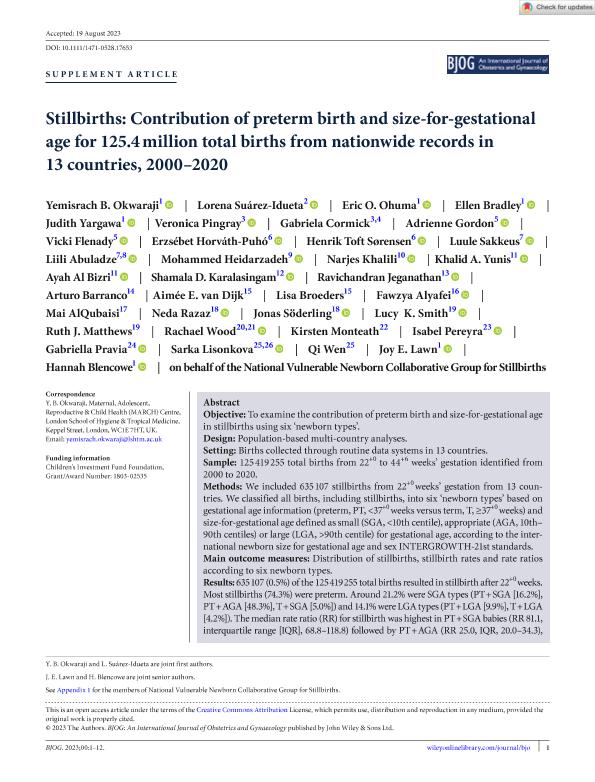Artículo
Vulnerable newborn types: Analysis of population-based registries for 165 million births in 23 countries, 2000–2021
Suárez Idueta, Lorena; Yargawa, Judith; Blencowe, Hannah; Bradley, Ellen; Okwaraji, Yemisrach B.; Pingray, María Verónica; Gibbons, Luz; Gordon, Adrienne; Warrilow, Kara; Paixao, Enny S.; Falcão, Ila Rocha; Lisonkova, Sarka; Wen, Qi; Mardones, Francisco; Caulier Cisterna, Raúl; Velebil, Petr; Jírová, Jitka; Horváth Puhó, Erzsebet; Sørensen, Henrik Toft; Sakkeus, Luule; Abuladze, Lili; Gissler, Mika; Heidarzadeh, Mohammad; Moradi-Lakeh, Maziar; Ohuma, Eric O.; Pravia, Gabriella; Lawn, Joy E.; Cormick, Gabriela ; Belizan, Jose
; Belizan, Jose ; National Collaborative Group for Vulnerable Newborn Prevalence
; National Collaborative Group for Vulnerable Newborn Prevalence
 ; Belizan, Jose
; Belizan, Jose ; National Collaborative Group for Vulnerable Newborn Prevalence
; National Collaborative Group for Vulnerable Newborn Prevalence
Fecha de publicación:
04/2023
Editorial:
Wiley Blackwell Publishing, Inc
Revista:
BJOG - An International Journal of Obstetrics and Gynaecology
ISSN:
1470-0328
Idioma:
Inglés
Tipo de recurso:
Artículo publicado
Clasificación temática:
Resumen
Objective To examine the prevalence of novel newborn types among 165 million live births in 23 countries from 2000 to 2021. Design Population-based, multi-country analysis. Setting National data systems in 23 middle- and high-income countries. Population Liveborn infants. Methods Country teams with high-quality data were invited to be part of the Vulnerable Newborn Measurement Collaboration. We classified live births by six newborn types based on gestational age information (preterm <37 weeks versus term ≥37 weeks) and size for gestational age defined as small (SGA, <10th centile), appropriate (10th–90th centiles), or large (LGA, >90th centile) for gestational age, according to INTERGROWTH-21st standards. We considered small newborn types of any combination of preterm or SGA, and term + LGA was considered large. Time trends were analysed using 3-year moving averages for small and large types. Main outcome measures Prevalence of six newborn types. Results We analysed 165 017 419 live births and the median prevalence of small types was 11.7% – highest in Malaysia (26%) and Qatar (15.7%). Overall, 18.1% of newborns were large (term + LGA) and was highest in Estonia 28.8% and Denmark 25.9%. Time trends of small and large infants were relatively stable in most countries. Conclusions The distribution of newborn types varies across the 23 middle- and high-income countries. Small newborn types were highest in west Asian countries and large types were highest in Europe. To better understand the global patterns of these novel newborn types, more information is needed, especially from low- and middle-income countries.
Palabras clave:
LOW BIRTHWEIGHT
,
NEWBORN
,
PRETERM BIRTH
,
SIZE FOR GESTATIONAL AGE
Archivos asociados
Licencia
Identificadores
Colecciones
Articulos(CIESP)
Articulos de CENTRO DE INVESTIGACIONES EN EPIDEMIOLOGIA Y SALUD PUBLICA
Articulos de CENTRO DE INVESTIGACIONES EN EPIDEMIOLOGIA Y SALUD PUBLICA
Citación
Suárez Idueta, Lorena; Yargawa, Judith; Blencowe, Hannah; Bradley, Ellen; Okwaraji, Yemisrach B.; et al.; Vulnerable newborn types: Analysis of population-based registries for 165 million births in 23 countries, 2000–2021; Wiley Blackwell Publishing, Inc; BJOG - An International Journal of Obstetrics and Gynaecology; 4-2023; 1-12
Compartir
Altmétricas



